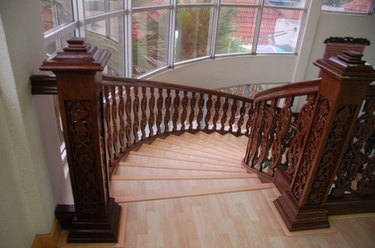Things You'll Need
Newspaper
Scissors
Utility knife
Stapler, carpet tacks or tack strip

While there are a variety of ways to carpet standard staircases, winding or pie-shaped stairs require special techniques and a bit more cutting. Because a single run of carpet cannot be laid on pie-shaped stairs, each step or pair of steps—depending on whether or not the steps are bull-nosed—must be separately upholstered using a method commonly known as the French tuck. This is not bad news. Not only are smaller pieces of carpeting easier to work with, but replacing stained carpet need not mean starting from scratch.
Upholstering Bullnosed Pie-Shaped Steps
Step 1
Lay a sheet of newspaper across the step flush to the riser and mark the edge of the step with chalk. Cut the paper about 2 inches from the chalk mark, then re-fit it on the step, making a crease where the paper hits the riser on the underside of the bull-nose. Cut again along the crease line. You now have a perfect template for the step.
Video of the Day
Step 2
Use your template and a utility knife to cut carpet for the first step. Secure carpet at the back of the step using a tack strip, carpet tacks or a stapler. Stretch the carpeting forward and underneath the bull-nose and fasten in place. Continue in this way to upholster each step.
Step 3

Measure the risers and cut rectangles to fit. Install carpeting on the risers using hot glue or carpet adhesive in order to prevent visible dimpling from fasteners.
Upholstering Plain Pie-Shaped Stairs
Step 1
Use newspapers to make a template for a section of carpet that will cover one step and the riser directly beneath it. Cut out corresponding sections of carpet and begin by installing the carpet using a tack strip, carpet tacks or staples.
Step 2
Move on to the next lower step before completing installation on the first. This is to allow placement of the second tack strip and carpet before the first piece of carpet is attached to the riser above it. If the carpet pieces are cut correctly, the portion covering the riser will fit snugly against the carpet already in place on the lower step, causing the seam to be nearly invisible. If the first piece of carpet buckles on the riser or upper stair, trim the carpeting as necessary to achieve a perfect fit.
Step 3
Continue in this way until installation is complete, cutting new newspaper templates as necessary. Even if the stairs appear to be uniform in size and shape, test your observation by first fitting your newspaper pattern before cutting a new carpet piece.
Tip
Bend carpet samples in half before making your purchase. Some weaves expose carpet backing when bent, and thus are not suitable for stairs.
Bear in mind that some geometric-patterned carpet may be hard to match on pie shaped stairs. At a minimum matching patterns may result in excess waste.
Carpet on the risers of plain steps will have greater strain placed upon it by virtue of its connection with the stair tread, so adding some discreetly placed fasteners in addition to carpet adhesive on the risers might make for a more stable and permanent installation.
Warning
Some installers use a single run of carpet to upholster pie-shaped stairs by folding back a wedge of carpet and tucking it behind the installation. While this saves, time, the result is not as attractive.
Video of the Day